Related Research Articles

Velvet is a type of woven tufted fabric in which the cut threads are evenly distributed, with a short, dense pile, giving it a distinctive soft feel. By extension, the word velvety means "smooth like velvet". In the past, velvet was typically made from silk. Today, velvet can be made from linen, cotton, wool and synthetic fibers.

A ribbon or riband is a thin band of material, typically cloth but also plastic or sometimes metal, used primarily as decorative binding and tying. Cloth ribbons are made of natural materials such as silk, cotton, and jute and of synthetic materials, such as polyester, nylon, and polypropylene. Ribbon is used for useful, ornamental, and symbolic purposes. Cultures around the world use ribbon in their hair, around the body, and as ornament on non-human animals, buildings, and packaging. Some popular fabrics used to make ribbons are satin, organza, sheer, silk, velvet, and grosgrain.
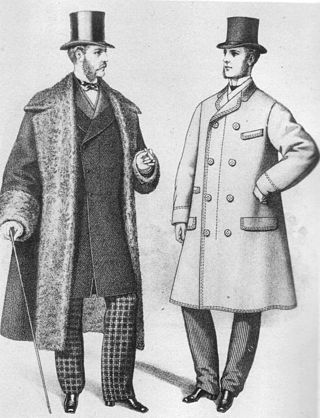
An overcoat is a type of long coat intended to be worn as the outermost garment, which usually extends below the knee. Overcoats are most commonly used in winter when warmth is more important.
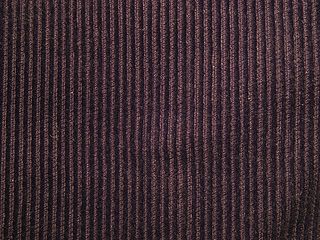
Corduroy is a textile with a distinctively raised "cord" or wale texture. Modern corduroy is most commonly composed of tufted cords, sometimes exhibiting a channel between them. Both velvet and corduroy derive from fustian fabric. Corduroy looks as if it is made from multiple cords laid parallel to each other.

Fustian is a variety of heavy cloth woven from cotton, chiefly prepared for menswear. It is also used figuratively to refer to pompous, inflated or pretentious writing or speech, from at least the time of Shakespeare. This literary use is because the cloth type was often used as padding, hence, the purposeless words are fustian.

A brigandine is a form of body armour from the Middle Ages. It is a garment typically made of heavy cloth, canvas, or leather, lined internally with small oblong steel plates riveted to the fabric, sometimes with a second layer of fabric on the inside.

Velveteen is a type of cloth made to imitate velvet, which is a type of pile fabric. Normally cotton, the term is sometimes applied to a mixture of silk and cotton. Some velveteens are a kind of fustian, having a rib of velvet pile alternating with a plain depression. This fabric has a pile that is short and is closely set. It has a firm hand and a slightly sloping pile. Compared to true velvet, velveteen has greater body, does not drape as easily, and has less sheen.
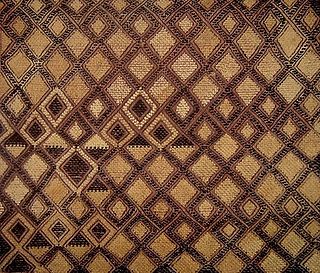
Velours du Kasaï is a kind of textile fabric made in Kasai, a province in the Democratic Republic of the Congo (Zaïre). Traditionally, the weaving is done by men of the Shoowa from the Kuba ethnic group, while the embroidery is reserved to women. Ideally, the embroiderers should be pregnant. The technique is still practised.
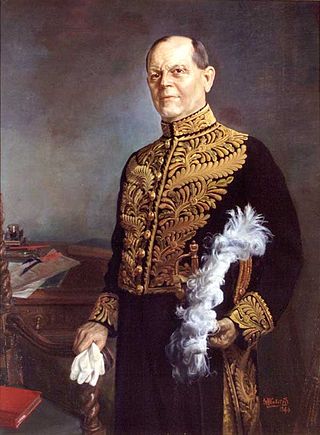
Court uniform and dress were required to be worn by those in attendance at the royal court in the 19th and early 20th centuries.
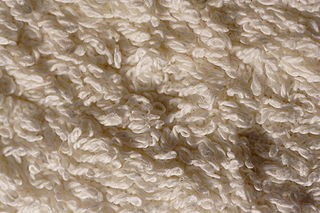
Terrycloth, terry cloth, terry cotton, terry toweling, terry, terry towel, Turkish toweling (formerly), or simply toweling is a fabric woven with many protruding loops of thread which can absorb large amounts of water. It can be manufactured by weaving or knitting. Terrycloth is woven on special looms that have two beams of longitudinal warp through which the filler or weft is fired laterally.
Academic dress at the University of St Andrews involves students wearing distinctive academic gowns whilst studying at the University of St Andrews. Undergraduate gowns in Scotland were once common at all the ancient universities of Scotland, with each having its own distinctive style. St Andrews undergraduates wear either a scarlet gown if they are part of the United College and studying in the Faculties of Arts, Medicine and Science, or a black gown if they are part of St Mary's College and studying in the Faculty of Divinity.
The manufacture of textiles is one of the oldest of human technologies. To make textiles, the first requirement is a source of fiber from which a yarn can be made, primarily by spinning. The yarn is processed by knitting or weaving, which turns yarn into cloth. The machine used for weaving is the loom. For decoration, the process of colouring yarn or the finished material is dyeing. For more information of the various steps, see textile manufacturing.

Primarily, nap is the raised (fuzzy) surface on certain kinds of cloth, such as velvet or moleskin. Nap can refer additionally to other surfaces that look like the surface of a napped cloth, such as the surface of a felt or beaver hat.
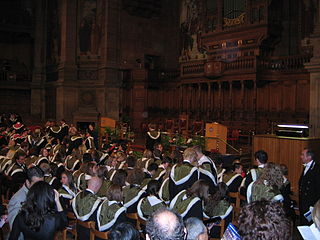
Academic dress at the University of Edinburgh is compulsory at official ceremonial occasions, such as graduation and the installations of Rector and Chancellor, and otherwise optional, usually only worn for events.

Kalaga is a heavily embroidered appliqué tapestry made of silk, flannel, felt, wool and lace against a background made of cotton or velvet indigenous to Burma (Myanmar). The word kalaga, which means "curtain," comes from the Burmese language, although Burmese refer to such tapestries as shwe gyi do. These tapestries use a sewing technique called shwe gyi (ရွှေချည်)
The academic dress of the Royal Melbourne Institute of Technology (RMIT) are the robes, gowns and hoods prescribed by the Australian university for the administration, faculty, graduates, postgraduates and undergraduates of its Australian and Vietnamese branches. The academic dress of RMIT is described as similar to that of the University of Oxford in the United Kingdom. The current statute of academic dress was approved by the RMIT Council in 1980.
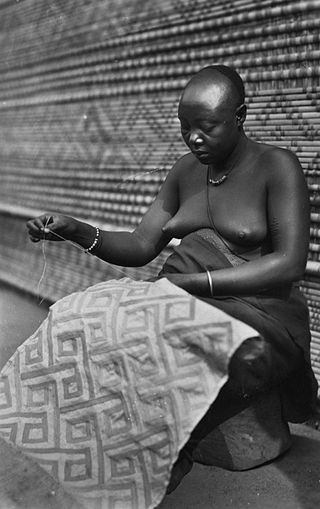
Kuba textiles are a type of raffia cloth unique to the Democratic Republic of the Congo, formerly Zaire, and noted for their elaboration and complexity of design and surface decoration. Most textiles are a variation on rectangular or square pieces of woven palm leaf fiber enhanced by geometric designs executed in linear embroidery and other stitches, which are cut to form pile surfaces resembling velvet. Traditionally, men weave the raffia cloth, and women are responsible for transforming it into various forms of textiles, including ceremonial skirts, ‘velvet’ tribute cloths, headdresses and basketry.

A covert coat or Crombie coat is a gentleman's overcoat typically with notched lapels which originated in the late 19th century as a "short topcoat" to be worn for hunting and horse riding.

Yūzen (友禅染) is a Japanese resist dyeing technique where dyes are applied inside outlines of dyed or undyed rice-paste resist, which may be drawn freehand or stencilled; the paste keeps the dye areas separated. Originating in the 17th century, the technique became popular as both a way of subverting sumptuary laws on dress fabrics, and also as a way to quickly produce kimono that appeared to be painted freehand with dyes. The technique was named after Miyazaki Yūzen, a 17th century fan painter who perfected the technique. Miyazaki Yūzen's fan designs became so popular that a book called the yūzen-hiinagata was published in 1688, showing similar patterns applied to kosode. A fashion for elaborate pictorial yūzen designs lasted until 1692.
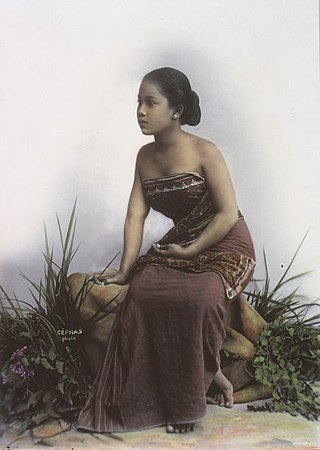
Kemben is an Indonesian female torso wrap historically common in Java, Bali, and other part of Indonesian archipelago. It is made by wrapping a piece of kain (clothes), either plain, batik printed, velvet, or any type of fabrics, covering the chest wrapped around the woman's torso.
References
- ↑ Syed Mohammad. "Masnat makers on the moribund". The Times of India . Archived from the original on 16 July 2012. Retrieved 31 January 2012.